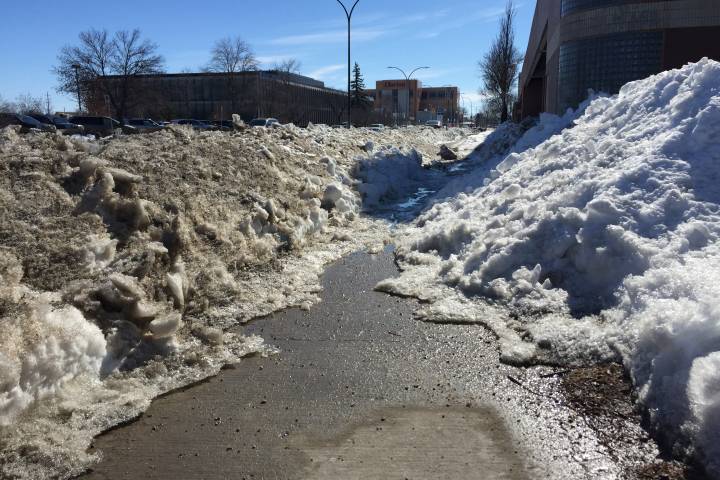After nearly two years worth of extensions, Winnipeg city staff have finally unveiled a plan that would place a higher priority on sidewalks and active transportation routes when it comes to snow clearing.

However, the city’s public works committee deferred decisions on the plan until next month.
Calls for a more effective winter strategy were amplified in March when a big blast of snow left many sidewalks in treacherous shape, swallowed by snow that had been cleared off the road.
Councillor Janice Lukes first requested the report in March 2016, giving staff 210 days to report back. After requesting seven separate extensions, the report was presented to the public works committee Tuesday, where councillors decided to hold off on approving it until they had a chance to look at the proposed maps in detail.
Advocates for cycling and active transportation are still grateful that some progress is being made.
“Winnipeg is a winter city. Our transportation system needs to reflect this reality for all of its users, not just those that find themselves behind the wheel of a car,” Bike Winnipeg’s Mark Cohoe told a city committee Tuesday.
“While Winnipeg’s cycling network has been expanding over the last ten years, the growing number of people who wish to continue riding their bikes through winter have often found that improvements to the cycling network that they see in the summer disappear in the winter.”
Winnipeg’s snow clearing strategy divides roads into three categories: priority 1 (P1), priority 2 (P2) and priority 3 (P3). P1 roads are cleared first and it can take a few days before P3 routes are addressed.
The conundrum for fans of active transportation (AT) lies in the fact that those smaller, lower priority streets are often the ones they use for commuting, away from main routes that contain heavy vehicle traffic. As such, it takes a lot longer for those roads to be accessible.
“AT routes do not necessarily and often don’t match up with priority 1 streets, so they require a separate approach,” Beth McKechnie with the Green Action Centre explained. “Surface conditions of an AT route are a better indicator of whether people will bike in winter than the actual temperature. You can dress for the temperature, but you may not have a shovel on your bike when you get to a pathway or lane that hasn’t been cleared.”
Implementing this re-prioritized active transportation strategy would cost $933,000 for the first year and $834,000 plus inflation every year after.
Anders Swanson with the Winnipeg Trails Association said that’s a nice start, but wants to see the city inject way more money into active transportation.
“You need to increase the budget heavily, and you need to signal that this is important. One thing this report doesn’t address is frequency. People who have mobility challenges, to add that as a barrier can put them completely out of the workforce. We’re studying a $500 million project on Kenaston. At that rate, we could clear the network that’s being proposed for 432 years.”
Councillors will come back to the report in June.








Comments